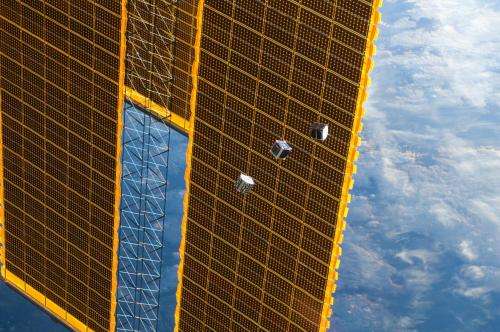March 19, 2015 report
Team suggests sublimating ice to propel CubeSats

(Phys.org)—A trio of researchers affiliated with Delft University in The Netherlands, has come up with a new way to provide propulsion for CubSats—use frozen water as fuel. In their paper published in Acta Astronautica, the team outlines their design and suggest there is just one hurdle still standing in their way—a means of keeping the water frozen while a CubeSat is awaiting launch.
Tiny satellites that have earned the nickname CubeSats, have become very popular in recent years—their small size allows for many of them to be launched from one rocket, dramatically reducing costs. But they all have one thing in common—lack of a propulsion system. That means they are not able to maintain an orbital altitude, which dooms them to reentry after just a few months. It also prevents them from being sent out into deeper space, such as to the moon, or even to other parts of the solar system. Thus far, several projects have been announced with researchers looking to find a way to balance weight and size relative to the amount of thrust that can be generated. In this new effort the researchers think the solution is to use and ice and a solar collector.
The team calls its system Ion Electrospray Propulsion System—it would work by taking advantage of ice sublimating in a space environment. The water molecules would be directed at a plate heated by solar power, which would cause them to move faster—directing them through a nozzle would generate just enough thrust, the team believes, to allow for controlling a CubeSat. The problem of course is how to keep the water frozen while a CubeSat is sitting on a launch-pad. The team does not have an answer for that but believe that if a solution can be found, their engine would be feasible—it would also require just five ounces of ice. That tiny bit of water might present another problem however, as it would account for ten percent of the allowable weight of a CubeSat, meaning there would be less for electronics or other gear. Also there is an issue of power utilization—heating the plate would take away from power that is currently used for other hardware.
Whole fleets of CubeSats or CubeExplorers doing both academic and amateur research is an exciting proposition, perhaps if ice does turn out to be the best fuel for them, NASA or commercial rocket companies will start providing freezing compartments for whole crates of CubeStas as part of a package deal.
More information: Conceptual design of a low-pressure micro-resistojet based on a sublimating solid propellant, Acta Astronautica, Volume 108, March–April 2015, Pages 30–39. www.sciencedirect.com/science/ … ii/S0094576514005001
Abstract
In the current and future trend towards smaller satellite missions, the development of a simple and reliable propulsion system with performance and characteristics in line with the typical requirements of nano-satellites and CubeSats plays a crucial role for enhancing the capabilities of this type of missions. This paper describes the design of a micro-resistojet using water stored in the frozen state (ice) as propellant, operating under sublimation conditions at low pressure. The low operating pressure allows for using the vapor pressure of ice as the only method of propellant feeding, thereby allowing for extremely low thrust and electric power usage. The results of an extensive set of numerical simulations for optimizing the thruster geometry in terms of power ratio and specific impulse produced are discussed. In addition, the design of the complete propulsion system is described. It makes use of a limited number of moving parts and two power sources, one in the thruster to increase the propellant temperature and one in the tank to maintain the propellant storage conditions. Results show that the proposed design represents an alternative option capable of meeting the typical requirements of small satellite missions by means of an intrinsically green propellant such as water, with the pressure inside the system never exceeding 600 Pa. Optimization results showed an optimum thrust to power ratio in range 0.2–1.2 mN/W for an expansion slot aspect ratio of 2.5.
via Newscientist
© 2015 Phys.org





















